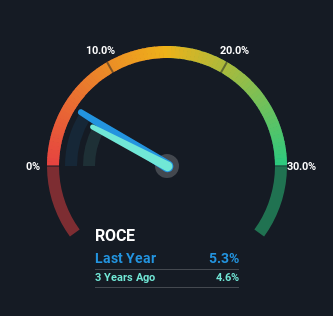- United States
- /
- Other Utilities
- /
- NYSE:ED
Slowing Rates Of Return At Consolidated Edison (NYSE:ED) Leave Little Room For Excitement
There are a few key trends to look for if we want to identify the next multi-bagger. Amongst other things, we'll want to see two things; firstly, a growing return on capital employed (ROCE) and secondly, an expansion in the company's amount of capital employed. Ultimately, this demonstrates that it's a business that is reinvesting profits at increasing rates of return. In light of that, when we looked at Consolidated Edison (NYSE:ED) and its ROCE trend, we weren't exactly thrilled.
Understanding Return On Capital Employed (ROCE)
For those who don't know, ROCE is a measure of a company's yearly pre-tax profit (its return), relative to the capital employed in the business. The formula for this calculation on Consolidated Edison is:
Return on Capital Employed = Earnings Before Interest and Tax (EBIT) ÷ (Total Assets - Current Liabilities)
0.053 = US$3.3b ÷ (US$68b - US$6.2b) (Based on the trailing twelve months to June 2024).
So, Consolidated Edison has an ROCE of 5.3%. Even though it's in line with the industry average of 5.0%, it's still a low return by itself.
Check out our latest analysis for Consolidated Edison

In the above chart we have measured Consolidated Edison's prior ROCE against its prior performance, but the future is arguably more important. If you're interested, you can view the analysts predictions in our free analyst report for Consolidated Edison .
What Can We Tell From Consolidated Edison's ROCE Trend?
There are better returns on capital out there than what we're seeing at Consolidated Edison. Over the past five years, ROCE has remained relatively flat at around 5.3% and the business has deployed 24% more capital into its operations. Given the company has increased the amount of capital employed, it appears the investments that have been made simply don't provide a high return on capital.
The Bottom Line
Long story short, while Consolidated Edison has been reinvesting its capital, the returns that it's generating haven't increased. And investors may be recognizing these trends since the stock has only returned a total of 34% to shareholders over the last five years. Therefore, if you're looking for a multi-bagger, we'd propose looking at other options.
Since virtually every company faces some risks, it's worth knowing what they are, and we've spotted 2 warning signs for Consolidated Edison (of which 1 is concerning!) that you should know about.
While Consolidated Edison may not currently earn the highest returns, we've compiled a list of companies that currently earn more than 25% return on equity. Check out this free list here.
New: AI Stock Screener & Alerts
Our new AI Stock Screener scans the market every day to uncover opportunities.
• Dividend Powerhouses (3%+ Yield)
• Undervalued Small Caps with Insider Buying
• High growth Tech and AI Companies
Or build your own from over 50 metrics.
Have feedback on this article? Concerned about the content? Get in touch with us directly. Alternatively, email editorial-team (at) simplywallst.com.
This article by Simply Wall St is general in nature. We provide commentary based on historical data and analyst forecasts only using an unbiased methodology and our articles are not intended to be financial advice. It does not constitute a recommendation to buy or sell any stock, and does not take account of your objectives, or your financial situation. We aim to bring you long-term focused analysis driven by fundamental data. Note that our analysis may not factor in the latest price-sensitive company announcements or qualitative material. Simply Wall St has no position in any stocks mentioned.
About NYSE:ED
Consolidated Edison
Through its subsidiaries, engages in the regulated electric, gas, and steam delivery businesses in the United States.
Average dividend payer and fair value.
Similar Companies
Market Insights
Community Narratives





